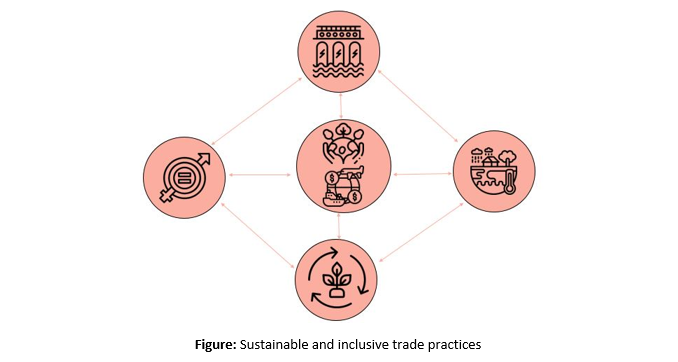The 2030 Agenda for Sustainable Development recognizes international trade as a catalyst for promoting inclusive economic growth, alleviating poverty, and attaining the Sustainable Development Goals (SDGs). However, for the world’s least developed countries (LDCs), international trade can be challenging let alone sustainable trade. Furthermore, the low participation of LDCs in trade has underscored the uncertainty of achieving Sustainable Development Goals (SDGs). These nations face numerous obstacles, including limited access to resources, rising debts, underdeveloped infrastructure, minimal exports, and vulnerability to climate change. To tackle these issues and foster trade-induced long-term growth, it is imperative to implement sustainable trade practices in Least Developed Countries (LDCs).
Understanding Least Developed Countries
Before delving into the intricacies of sustainable trade practices, it’s crucial to define ‘least developed countries’. According to the United Nations, LDCs are characterized by low income, limited human development indicators, and economic vulnerability that obstruct sustainable development. The majority of the LDC countries are in Africa (33), followed by Asia Pacific (11) and the Caribbean (1). The 45 LDC countries are also highly dependent on the trade of primary commodities and often lack diversified exports, making them more susceptible to fluctuations in the global economy. Furthermore, LDCs face a disproportionate impact of climate change although their contribution to it is miniscule.
The Importance of Trade for LDCs
For LDCs, international trade offers a sustainable economic development and poverty reduction pathway. Trade can stimulate economic growth by increasing market access for goods and services, attracting foreign investment, promoting tourism, and fostering technology transfer. Moreover, it can enable LDCs to utilize global value chains, where they can provide labor-intensive or resource-based inputs, thus creating employment opportunities and income generation. However, realizing these benefits is far from straightforward for LDCs. They face a range of trade-related challenges, including trade imbalances, tariff barriers, non-tariff measures, geographical obstructions, and limited productive capacity. Additionally, the adverse impacts of climate change further exacerbate their vulnerabilities, as many LDCs are located in regions extremely susceptible to extreme weather events.
Sustainable Trade Practices
 Sustainable trade practices encompass various strategies and plans to promote economic growth while preserving environmental integrity and social equity. These practices are particularly relevant for LDCs, as they address the unique challenges these countries face. There are various issues surrounding the implementation of sustainable trade in the least developed countries some of which are discussed below.
Sustainable trade practices encompass various strategies and plans to promote economic growth while preserving environmental integrity and social equity. These practices are particularly relevant for LDCs, as they address the unique challenges these countries face. There are various issues surrounding the implementation of sustainable trade in the least developed countries some of which are discussed below.
Diversification of Exports: One key sustainable trade practice for LDCs is diversifying their export base. Overreliance on a single commodity or product can make these nations highly vulnerable to fluctuations in global markets. By expanding their range of export products, LDCs can mitigate this risk and promote long-term economic stability. The World Trade Organization (WTO) member countries agreed to the so-called ‘services waiver,’ which allows WTO members to offer preferential treatment to services and service suppliers from LDCs. Diversification into services trade is rising in LDCs but not without challenges such as less productivity, and lack of the latest technology and skilled human resources.
Inclusive Trade Policies: Sustainable trade practices should be inclusive, ensuring that the benefits of trade reach all segments of society. Countries like Canada have been at the forefront of promoting inclusion in international trade. This includes measures to enhance the participation of women, indigenous communities, and marginalized groups in trade-related activities. Inclusive policies help reduce inequality and promote social equity in the world’s poorest nations.
Environmental Sustainability: LDCs often possess valuable natural resources, such as minerals and forests. Sustainable trade practices involve the responsible management of these resources to ensure their long-term availability. This includes implementing environmental regulations and promoting eco-friendly production methods.
Infrastructure Development: Adequate infrastructure, including transportation and energy systems, is vital for trade. Sustainable trade practices in LDCs emphasize the development of infrastructure that supports trade activities while minimizing environmental impact.
Climate Resilience: Trade can be an impactful tool for promoting climate resilience. Given their susceptibility to climate change, LDCs must integrate climate resilience into their trade strategies. This includes diversifying agricultural practices, building climate-resilient infrastructure, and promoting clean and renewable energy sources.
Challenges to Sustainable Trade in LDCs
While sustainable trade practices are admirable, putting them into effect in LDCs is riddled with multi-faceted challenges. LDCs frequently lack the financial and human resources needed to effectively formulate and implement sustainable trade policies. In this context, international support and capacity-building efforts are critical. LDCs confront a variety of trade barriers, including tariffs and non-tariff measures, that can obstruct their access to global markets. Advocating for fair and equitable trade agreements, as well as lowering trade barriers, is critical. A lack of infrastructure may hinder the flow of goods and services. Addressing infrastructure gaps is costly and time-consuming, yet it is necessary for long-term trade. Sustainable business operations frequently necessitate specialist technological understanding. It is critical to strengthen the capability of LDCs through training programs and knowledge-sharing efforts. Many LDCs are dealing with political unrest, which may impede commerce. Promoting good governance and a stable political climate is a requirement for long-term trade. In Nepal, for example, the new Nepal Trade Integration Strategy (NTIS) 2023 was introduced after a seven-year delay due to multiple government changes.
Success Stories in Sustainable Trade
Despite these challenges, several LDCs have made significant strides in adopting sustainable trade practices. Some of the examples from different countries are described in the following paragraphs. Countries like Ethiopia have diversified their export base by focusing on horticultural products such as flowers and vegetables. This strategy has created employment opportunities and reduced the country’s dependence on a single commodity. Bangladesh has leveraged its ready-made garments industry to become a major player in the global textile market along with ranking higher than neighboring India in the Sustainable Trade Index 2022. Similarly, Rwanda’s Coffee Sector has improved the livelihoods of small-scale farmers and also minimized environmental impact. Nepal and Bhutan have also been promoting sustainable tourism practices to gain foreign currency. This has created economic opportunities while preserving the environment and local culture.
The Role of International Support
International support through initiatives like aid for trade is critical in helping LDCs better adopt sustainable trade practices. Providing technical expertise to help LDCs develop sustainable trade policies and build capacity in trade-related areas. Financial Assistance like aid, grants, and low-interest loans to fund infrastructure development and sustainable trade initiatives. Trade capacity building for LDCs in enhancing their trade-related skills and knowledge through training programs and workshops. Similarly, LDCs should be facilitated with market access by reducing trade barriers and promoting fair trade agreements. Lastly, supporting LDCs in their efforts to adapt to climate change and develop climate-resilient infrastructure.
Conclusion and Way Forward
Sustainable trade practices have enormous potential to promote economic development and poverty reduction in the world’s least developed countries. Diversifying exports, encouraging inclusion, ensuring environmental sustainability, improving infrastructure, and enhancing climate resilience are all examples of these approaches. While LDCs confront several hurdles in implementing sustainable trading practices, success stories from Ethiopia, Bangladesh, Rwanda, and Nepal show that such green trade policies are feasible. Additionally, more and more developing countries are recognizing the importance of the environment in trade. International assistance in the form of technical assistance, financial assistance, and trade capacity building is critical in assisting LDCs in overcoming their restrictions and embarking on a path toward sustainable trade. LDCs may unlock their economic potential and contribute to a more equitable and sustainable global economy by adopting these practices and obtaining the required support. Therefore, for LDCs sustainable trade practices are not just an option; they are a necessity.
Sagar Jung Karki works as beed at beed management, having previously interned at the Institute for Integrated Development Studies (IIDS). His core areas of interest include international business, trade, entrepreneurship, and digitalization. He holds an MSc in International Business from the University of the West of England. As a global-minded individual, Sagar aspires to become a pracademic, contributing positively to the world.





